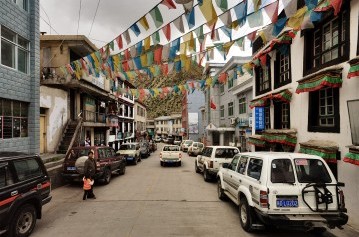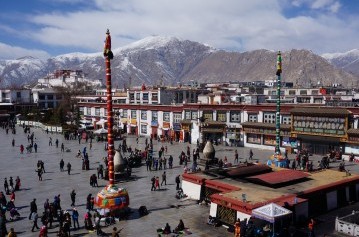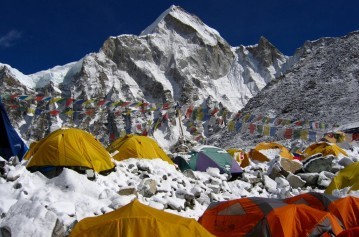Tibet: "Land of Unparalleled Beauty and Mystique"
Tibet is one of the most unusual and beautiful countries with a unique landscape. The majority of Tibetan land rests above 4000 meters (13,000 feet) and is partially surrounded by majestic mountain ranges. The awe-inspiring highest Himalayas in the world can be seen from Tibet, along with the never-ending Tibetan plateau. Tibet is a place for the rugged adventurer as well as the spiritual wanderer—a land held back in time, housing many secrets. Nomads remain much the same as they did one hundred years ago in Tibet, and the monasteries strive to find a place in a country rapidly modernizing.
The Tibetan people and their religion are inseparable. Even in their earliest myths, one finds references to the Tibetan's religious beliefs. Originally, the Bon religion dominated Tibet. After the introduction of Buddhist statues and later Sanskrit documents from India, Buddhism increasingly integrated into Tibetan culture. Tibetan Buddhism is the culmination of early Bon beliefs, Indian Buddhist texts, and teachings from several great lamas. Buddhism and politics have been interwoven since King Songtsen Gampo married Chinese and Nepali princesses, both integral in the emergence of Buddhism. The Fifth Dalai Lama built the Potala Palace as the government's seat and a religious center, establishing a theocracy that prevailed until 1951.
After centuries of virtual isolation, Tibet is cautiously opening up to the western world. Officially, China has opened its doors to travelers only in recent years. A visit to Tibet is a marvelous experience, though it is not for the faint-hearted. Traveling in Tibet is difficult, adventurous, and unpredictable. Yet, it offers a dream come true experience and the adventure of a lifetime.
Facts About Tibet:
- Area: 1.2 million sq km (471,700 sq miles), Bod: 2.5 million sq km, approximately the size of Western Europe
- Population: 2.62 million
- Religions: Tibetan Buddhism, Animism
- Ethnic Groups: Primarily ethnic Tibetans; also Menba, Lhoba, Mongols, Hui, and a growing number of Han Chinese
- Culture: Wedding, Funeral traditions
- Languages: Tibetan, Chinese
- Festivals: Tibetan New Year, Shoton Festival, Bathing Festival, and more
- Currency: Chinese Yuan Renminbi (CNY)
We, the team at Asian Adventure Treks & Expedition, offer tailor-made as well as customized travel packages to Tibet. Our offerings include the Kailash Mansarovar Tour combined with Lhasa (optional), Tibet Lhasa Tour, Lhasa Overland Tour, and more. Inquire with us to book your travel package to Tibet and embark on an unforgettable journey.
Explore Tibet with us and experience the magic of this enchanting land.
Featured trips for Tibet: "Land of Unparalleled Beauty and Mystique"
Easy trekking are basically for the beginners. This kind of treks is typically done in the lower hilly region of elevation below 3500 metre. The trails in this trek are generally vertical and walking time is 3 - 5 hours everyday.
Moderate types of trekking generally take place on the low altitude zone crossing the passes below the elevation of 4500 meters. Normally the walking is from 4 - 6 hours each day.
Hard kind of trekking routes crosses through the wild and adventurous trails and sometimes passes through the snow covered high passes between 4500 meters to 5500 meters. Usually the walks takes from 7-8 hours everyday.
Generally this types of routes are demanding long distance treks where the walks takes up to 9 hours each day. Each trail crosses at least one pass over 5500 meters frequently contains hardly ever explored regions. Challenging are the expedition types of activity.





